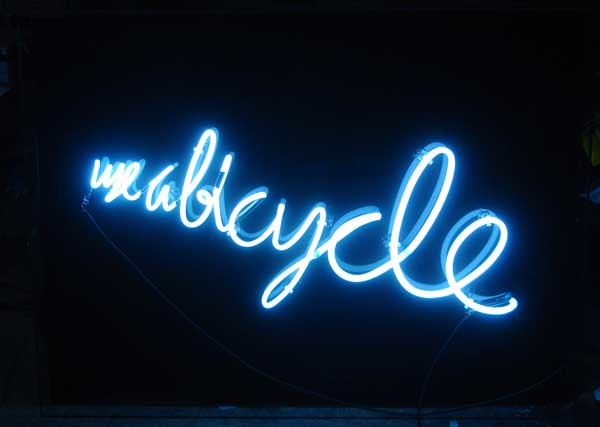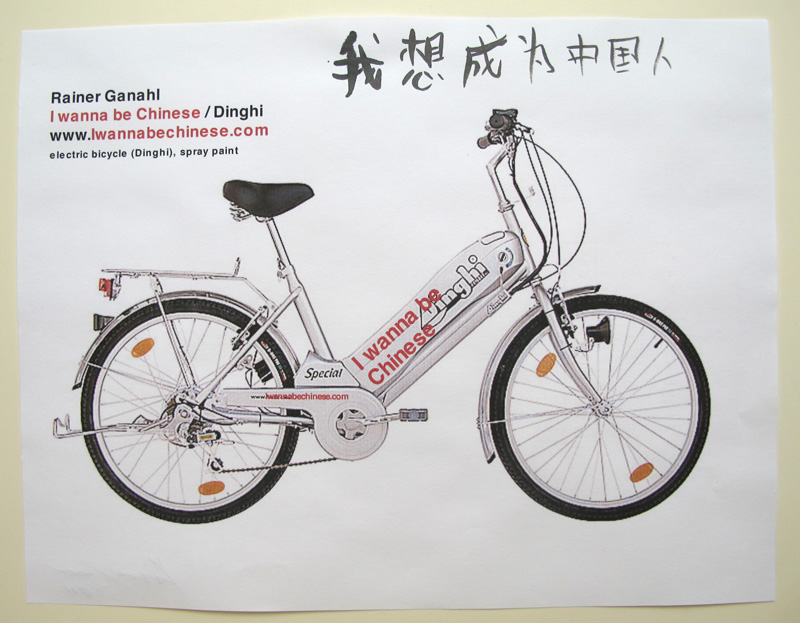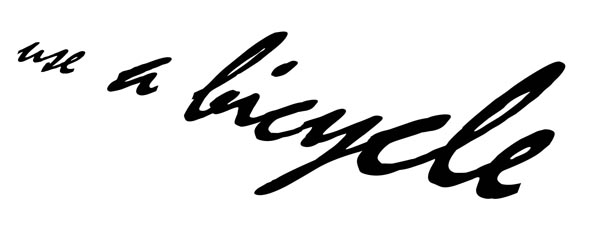Use a bicycle, (neon) 2006 - click to enter a bike ride by Rainer Ganahl
The Passion considered an uphill bicycle race, or I wanna be Alfred Jarry, 1903/2011, Tyrolian Alps bike VIDEO 2011
Youtube Tyrolian Alps bike VIDEO 2011
I wanna be Chinese, Dinghi E-bicycles from China, 2011
dvd, 4 min, plus DINGHI electric bicycle, edition of 10 (every collector is asked to purchase a DINGHI e-bike and use it)
an updated version of the famous 1950s song "tu voi far' l Americano ... now modified to " Tu voi far proprio cinese
more bike stuff
Bicycle Manifesto - 50 % Of All Streets To Be Converted Into Bikeways.
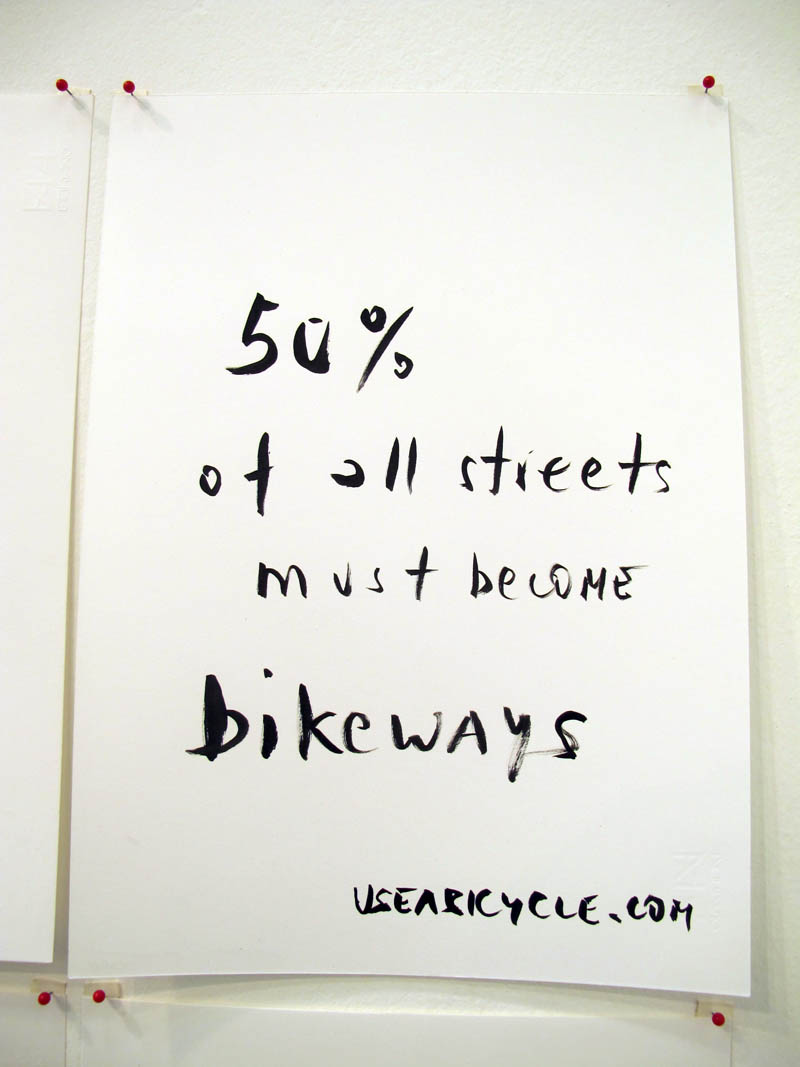
Modern cities were made for cars. Older cities are used as if made for cars with the exception of small pedestrian zones turned into shopping malls. Neither of them accommodates bicycles.
In recent years, in certain cities we have seen the introduction of bicycle lanes. This is a good start but by far not sufficient.
What this Bicycle Manifesto demands can be summed up in one sentence: 50 % of all streets of any city should be reserved for bicycles and electric bicycles. These special lanes should be called bikeways.
Only high speed highways as well as pedestrian zones should be exempt from this rule. Motorcycles or scooters that don't run on batteries or exceed the speed of 32 km (20 miles)an hour should not drive on bikeways. Nor should there be pedestrians allowed.
With this rule, we don't have to ask or beg for more courtesy and respect towards cyclists, and pedestrians don't have to fear bicyclists when they step onto their bike lanes so often stolen from pedestrian territory. Bike lanes don't belong on sidewalks and they shouldn't ornate streets. Bikeways should be like separate street lanes that are clearly separated from car lanes and pedestrian walk ways.
Traffic engineering theory has to acknowledge that cyclists (including e-cyclists) are a growing class of species that cannot be viewed as lawless fast pedestrians or powerless car drivers.
What is to be gained and what is to be lost with such a 50 % solution ?
The introduction of pedestrian zones in the 1960s and 1970s in northern Europe was not an easy imposition. People were too much accustomed to drive up everywhere anytime a day. But the reality behind pedestrian zones is that these traffic less city areas became open air shopping malls hence the economic gain justified for the inconvenience for traffic.
This shopping mall logic explains why there aren't any significant pedestrian areas in major American cities: In the same era pedestrian zones sprang up in nearly every German, Swiss and Austrian city, the American dream lead middle class people on newly built highways into suburbs and right next to shopping malls without giving much attention to inner cities that started to decay.
Given this precedent, what would there be gained if existing streets would have to be divided and shared equally with cyclists? For sure, there wouldn't be any more shopping. There might be even less consumption since cyclists can't fill up trunks and backseats. But the gain would be a massive improvement of the quality of life with 50 % less air pollution, healthier, slimmer and hopefully happier people who suffer less from strokes, heart attacks and obesity than car drivers.
If cycling is made safer and more efficient, more people would ride on their bikes. More cyclist on save bikeways will inspire more people to ride and the perception of the city changes: people would discover that their cities can easily be cross by bike.
In this game electrical bikes -e-bikes -are not an alternative to bicycles but an alternative to cars. The car traffic would for sure be diminished and the pattern of transportation will change. Even consumption and cooking habits might change as smaller open air markets with fresh and locally produced products can have a renaissance and invite people to cook differently. In most cities cyclists move as fast or even faster as cars do today.
If bikeways become a reality travel time will be reduced for even cars since many people will opt for bicycling or e-cycling. The use of e-bikes offers pure biking and/or electric assisted biking which guarantees effortless mobility that can compete with the comfort of heated cars.
Generous bikeways will be not only the alternative to the current mostly dangerous bike reality but will be an invitation for more cyclists to hit the road and more cars to give up on driving.
This all will lead to an improvement in the quality of life, to environmental gains, to finally further changes in urban politics and urban transportation which need to be implemented. We need better bike parking facilities, effective bike sharing programs, i. e. cheap rent a bike networks throughout the city.
Bicycle and tricycle traffic combined with e-bike technology can be made so effective that even regular and bulky goods, products and services - taxis, kiosks, etc. - can be offered by bicycle as it is still the case in China and in places where developing and developed economies meet. Bicycles are not very economic and nonpolluting modes of urban transportation but also very quiet.
Given the implementation of bikeways that share all available streets equally with cars, easy riding on bicycles will guarantee easy living thanks to cheap, much healthier and environmentally friendly transportation. Once the infrastructure is in place, a massive re-education will take place and people of all ages and in all physical shape will resort to bicycles or e-bicycles.
Rainer Ganahl , New York, January 2011
some important technical data on e-bikes taken from the latest NY Times article Gaining a Toehold for the E-Bike By BRAD STONE Published: January 16, 2010
The earliest e-bikes of the 1990s got about 15 miles on a single charge. The Eneloop’s battery can power the bike about 46 miles before it needs to be plugged into an outlet and recharged for around three hours; it also partially recharges when the rider brakes or coasts downhill.
The federal government resolved the legal obstacle with legislation in 2002, classifying any two-wheel, pedal-driven bike with a maximum speed of 20 miles an hour as a bike, which does not need turn signals or licensed riders.
In the 1990s, ....Their bikes had heavy steel frames and the same lead acid batteries used in automobiles, which themselves could weigh 80 pounds. The entire Eneloop weights about 50 pounds.
This manifesto is open for suggestions and discussions:
just email me: useabicycle @ yahoo.com
I AM DISCUSSING THE CONTENT AND DEMANDS OF THIS MANIFESTO IN BOLOGNA WITH ITALIAN POLITICIANS AND THEORETICIANS AS PERFORMANCE (january 2011)
MORE DISCUSSIONS ARE TO BE HOLD - PLEASE MAKE THESE DISCUSSIONS HAPPEN FOR A BETTER WORLD
USE A BICYCLE is sponsoring the german bicycle duo: Holm and Julia bicycling from Stuttgart Germany to New Zealand: a many months long trip, longer then hte 10.000 Miles race, Alfred Jarry was writing of in 1903.
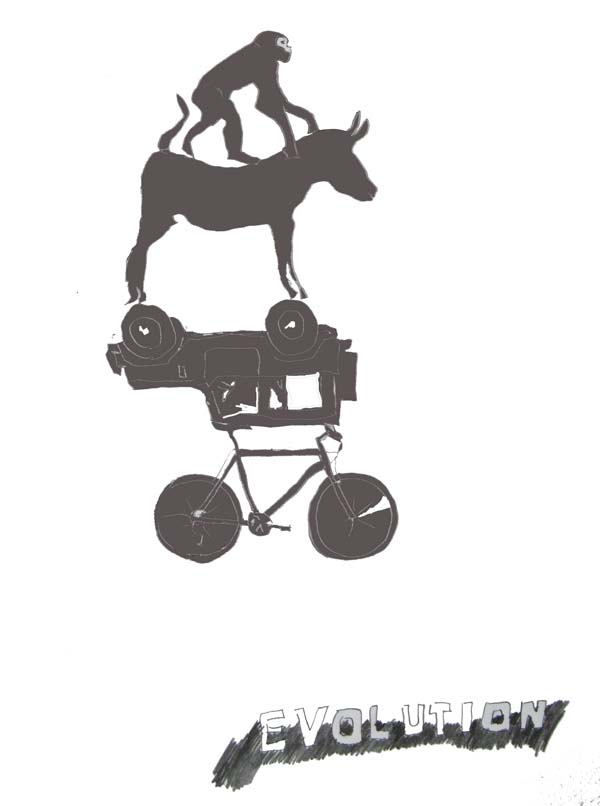
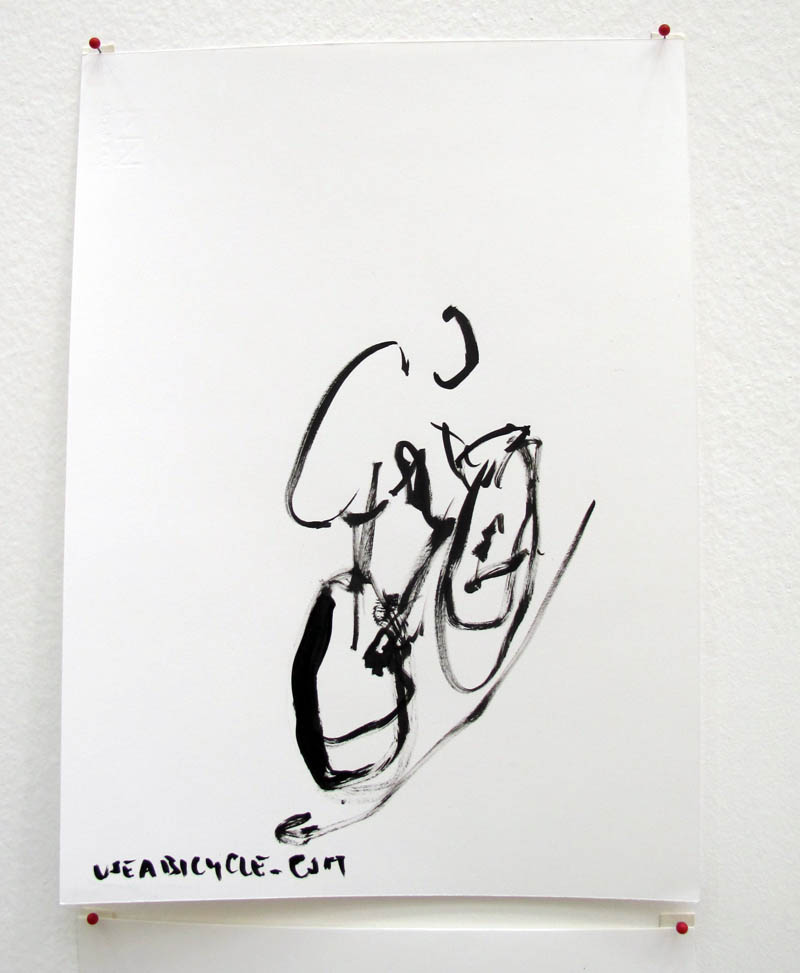
The apprentice in the sun, 1914/2011
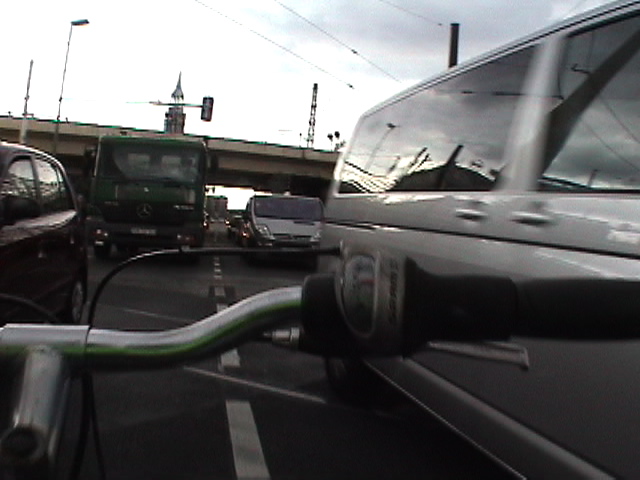
Bicycling from Karl-Marx-Allee through the Brandenburger Gate - Meditating Berlin 1989, 2007
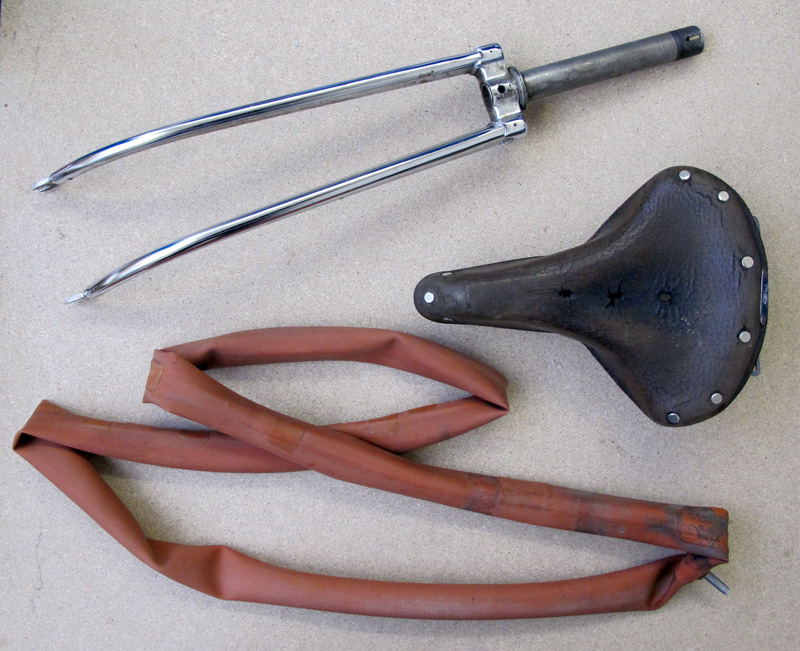
Counting backwards, Approaching the era of Alfred Jarry (1873 - 1907), 2011
materials: bicycle inner tube (caoutchouc / natural rubber), 1930s; bicycle saddle (leather and metal fixture) 1930s/40s; bicycle fork (metal)1960/70s
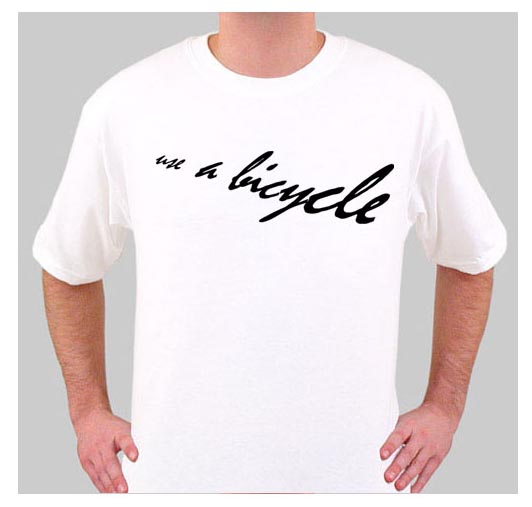
click to get high res. logo: for your own tshirt
see also our food (almost as good as doping ) partner: PERPETUAL MOTION FOOD
Use a bicycle --- view if 18 years and older only
also see
the biggest bicyclist ever: Alfred Jarry
